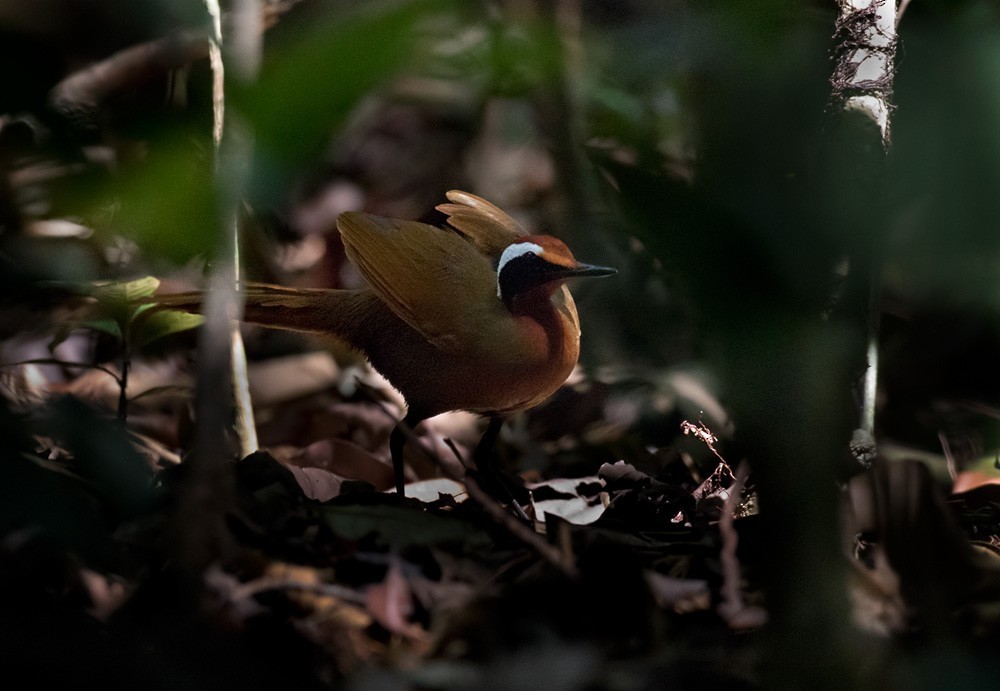Rail-babbler
A species of Malaysian Rail-babbler Scientific name : Eupetes macrocerus Genus : Malaysian Rail-babbler
Rail-babbler, A species of Malaysian Rail-babbler
Botanical name: Eupetes macrocerus
Genus: Malaysian Rail-babbler
Content
Description General Info
 Photo By Lars Petersson
Photo By Lars Petersson Description
It is a medium-sized, fairly slender songbird, about 28 to 30 cm (11–12 in) in length, and weighing 66 to 72 g (2.3–2.5 oz). It has a long thin neck, long black bill, long legs and a long tail. The plumage is mainly brown with a more reddish forehead and crown, and the foreneck, chin and throat are a rich chestnut. It has a long, black eyestripe extending from the bill to the side of the neck and a broad, white supercilium above it. There is a strip of bare, blue skin on the side of the neck which can be seen when the bird calls and displays, and probably has signalling significance in a dark species living in low light on the forest floor. The two sexes are the same. Juvenile birds are similar to the adult but are overall duller in colour, have a whitish throat and dark grey-brown belly. The subspecies borneensis is similar to the nominate race except that the head is a richer brown colour, the upperparts, including the tail, are much more red and the underparts more rufous. It has a long, monotonous whistling call. When agitated, it gives a series of frog-like notes. 
Size
30 cm
Nest Placement
Tree
Feeding Habits
Rail-babbler consumes insects like cicadas and beetles, as well as spiders, foraging terrestrially by dashing over forest floors. Exhibits unique timidity, showing preference for running over flying when disturbed.
Habitat
The rail-babbler inhabits dense, mature forests, often with a closed canopy and a structured understory, including primary rainforests and areas that have undergone selective logging. It is also found in swamp forests and heath forests within broadleaf evergreen forest zones, predominantly in lowland to submontane regions across the Malay Peninsula, Sumatra, and Borneo.
Dite type
Omnivorous
General Info
Feeding Habits
Bird food type
Behavior
It is a shy and secretive bird, which lives on the forest floor. It walks like a rail, jerking its head in the manner of a chicken, and it prefers to run rather than fly when disturbed. It feeds mainly on insects, including cicadas, and beetles; spiders and worms. When feeding it will dash after prey items. Little is known about its breeding habits. The eggs are laid around January and February and fledglings have been seen in June. The nest has been described as being placed near the ground on a pile of dead leaves among the stalks of a plant around 30 cm (12 in) from the ground. It is made of plant fibres and is a cup shape. The clutch is two white unmarked eggs, nothing else is known. 
Distribution Area
It is found on the Malay Peninsula in southern Thailand and Peninsular Malaysia and in the Greater Sundas on Sumatra, Borneo and the Natuna Islands. It mainly occurs in tall, lowland forests and also in swamps and heath forest. It sometimes occurs in lower montane forests up to about 1,060 m (3,480 ft) in Peninsular Malaysia and 900 m (3,000 ft) in Sumatra and Borneo. It is believed to be declining due to loss and degradation of the forest and is classed as near threatened. 

 Photo By Lars Petersson
Photo By Lars Petersson Scientific Classification
Phylum
Chordates Class
Birds Order
Perching birds Family
Rail-babblers Genus
Malaysian Rail-babbler Species
Rail-babbler